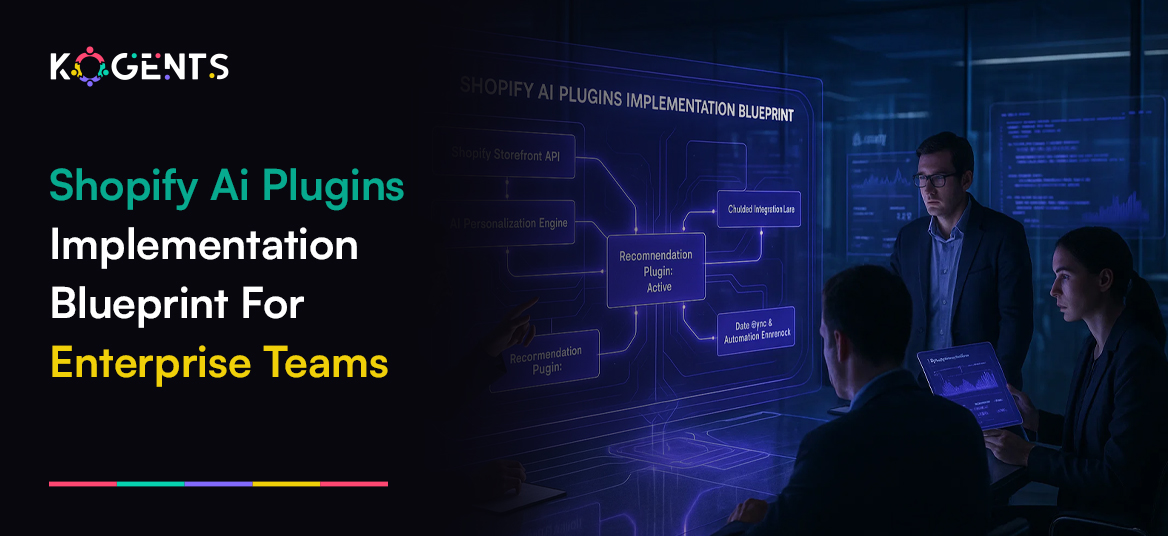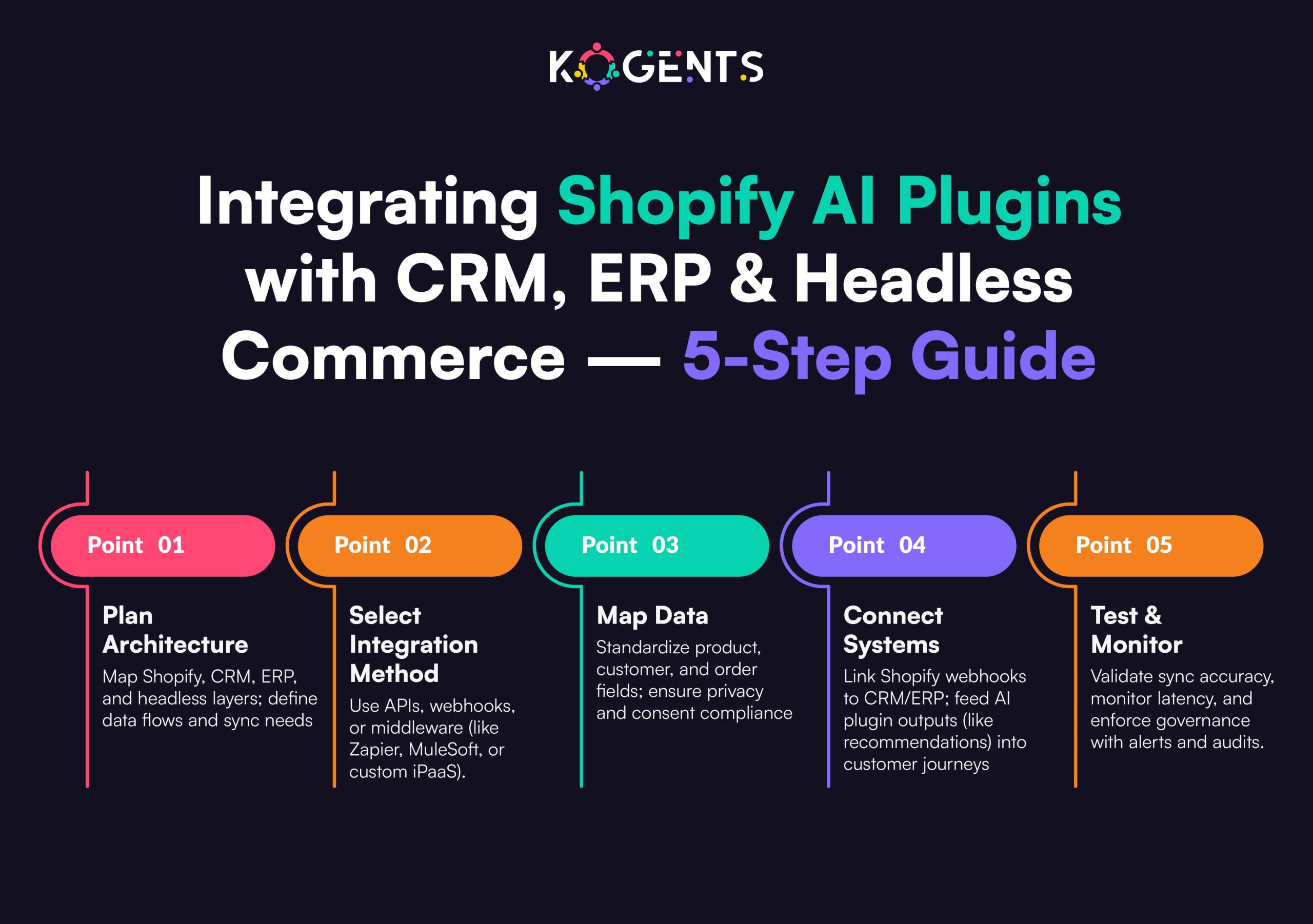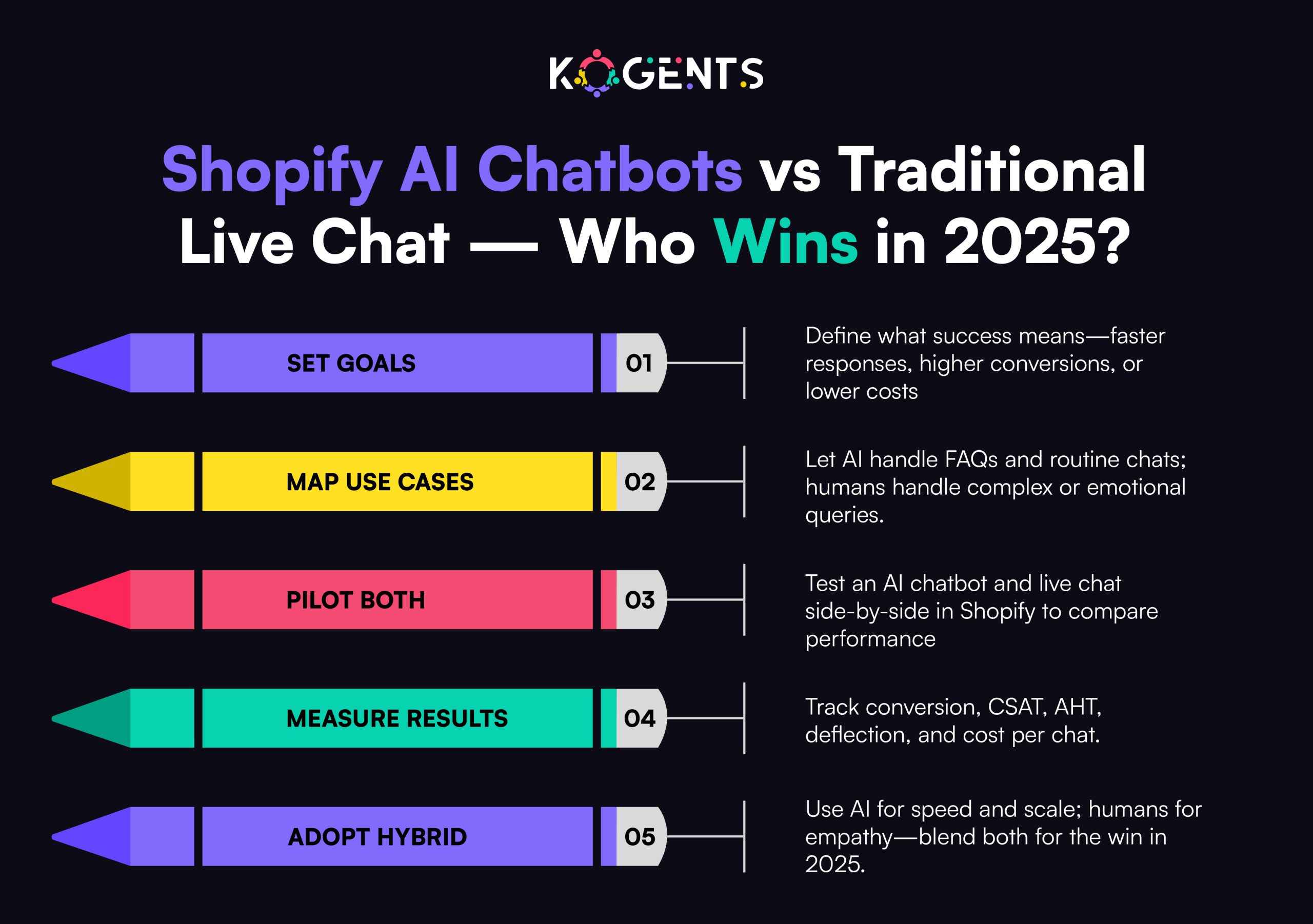Shopify AI Plugins Implementation Blueprint for Enterprise Teams

Summary:
Do you know that in a digital commerce environment, enterprise ecommerce teams cannot just rely on incremental gains?
They need quantum leaps: smarter automation, richer personalisation, faster decision-making, and deeper insight.
That’s where Shopify AI plugins step in.
Whether you call them Shopify artificial intelligence plugins or Shopify automation tools, these tools represent a pivotal evolutionary leap in how enterprise teams implement technology on the Shopify platform.
Imagine your team having an AI-powered Shopify app that drives a generative-AI plugin for Shopify that writes and localises an AI-enabled machine-learning plugin that predicts which segments will buy next.
This isn’t futuristic fluff but enterprise commerce in motion.
This blog post presents a detailed implementation blueprint designed for enterprise teams, not just small merchants, so that you can embed the Shopify AI plugin for store success.
Key Takeaways
- Deploying Shopify AI plugins means more than installation; it demands strategic alignment, architecture, and change management.
- Clean, structured data and defined metrics are preconditions for success with machine-learning and generative-AI plugins.
- Measuring uplift allows enterprise teams to quantify ROI and justify investment.
- Workflow integration, where recommendations, chat-bots, content-generation, and search live inside core commerce flows, is what drives scale.
- Continuous optimization and governance (rather than a “set-and-forget” mindset) separate enterprises that benefit from those that don’t.

Why Shopify AI Plugins Matter for Enterprise Teams?
Enterprise teams running Shopify stores face scale, complexity, and high expectations: multi-brand, multi-region, high SKU counts, international logistics, and omnichannel.
A generic installation of a plugin won’t cut it.
They need a smart product recommendation engine, a Shopify virtual assistant, a personalisation engine for Shopify, AI-powered Shopify app capabilities embedded into workflows, data streams, and strategic roadmaps.
By deploying Shopify AI plugins, you unlock:
- Ecommerce automation at scale: routine tasks handled by AI, freeing your team for strategic work.
- Generative AI for ecommerce content at scale, reducing time-to-market and cost.
- Data-driven insights via machine learning: predictive analytics, segmentation, conversion-rate optimisation.
- Workflow automation Shopify plugin capabilities: trigger-based upsells, abandoned cart recovery, and AI-enabled search.
- Personalisation across touchpoints: AI-powered search, smart recommendations, tailored emails, and content.
- Improved UX and lower returns: better product fits, fewer mis-purchases, and higher customer satisfaction.
Building Your Blueprint – A Step-by-Step Implementation Framework
Below is the detailed blueprint to guide enterprise teams through selecting, implementing, and scaling Shopify AI plugins.
Phase 1: Audit & Strategy
- Map all relevant workflows: product listing, merchandising, search, checkout, abandoned cart, post-purchase, returns.
- Identify pain-points: high return rate, low average order value (AOV), long product-description cycle, low conversion on mobile, and high customer-service load.
- Define success metrics: e.g., “increase average order value by 12%”, “reduce abandoned cart rate by 8%”, “reduce returns by 5%”.
- Inventory your data: product catalogue, customer history, segmentation, behaviour logs, chat transcripts, returns data. AI‐driven features rely on clean data.
- Select the relevant Shopify AI plugins use-cases: e.g., the Shopify AI recommendation plugin, the best Shopify AI chatbot plugin, the Shopify AI image generation plugin, and the Shopify machine learning plugin.
- Define your governance, compliance, and security policies
- Decide on roll-out strategy: pilot → phased deployment → full scale.
Phase 2: Selection & Architecture
- Map functional requirements to the variation list: best AI plugins for Shopify, Shopify AI plugin for ecommerce, Shopify AI plugin for marketing.
- Evaluate vendors based on factors: Shopify compatibility, API support, scalability, data governance, customisation, and cost.
- Consider native vs third-party: e.g., Shopify’s own offerings (e.g., “Shopify Magic”) vs independent plugins.
- Define architecture: where will the plugin live (Shopify admin, external micro-service, headless layer)? How will it connect to your data warehouse, CRM, and CDP?
- Data flow diagram: product data → AI module → customer segmentation → recommendation output → front-end.
- Define triggering logic for workflow automation.
- Choose metrics & dashboards; plan for instrumentation and analytics.
Phase 3: Installation & Integration
- Install plugin via Shopify App Store or via private app if custom.
- Configure according to enterprise needs: territory/language support, SKU volume, brand consistency, merchant teams.
- Integrate with your core systems: PIM (Product Information Management), CRM, email/SMS automation, and analytics.
- Build or leverage APIs to feed data into the plugin’s ML model.
- Set up front-end user experience changes: product page recommendations, chatbot widget, dynamic email templates, and image generation flows.
- Execute pilot deployment while monitoring logs and metrics.
- Ensure UX and UI consistency with brand guidelines.
Phase 4: Training, UX, and Change-Management
- Train internal teams: merchandising, marketing, customer service, analytics, all should know how to use the plugin features, interpret outputs, and adjust logic.
- Update workflows: shift from manual processes to AI-enabled flows
- Monitor user behaviour: are shoppers engaging with recommendations? Are chatbot returns being accepted?
- Feedback loop: collect data from UI metrics, revise plugin configuration, or model parameters.
- Address governance: ensure data privacy (esp. across regions), verify model output quality, and remove bias.
Note: Roll out across teams gradually to avoid disruption.
Phase 5: Measurement, Optimisation & Governance
- Monitor KPIs established in Phase 1: Use dashboards to assess conversion lift, AOV lift, return-rate reduction, customer-service deflection, and content-creation time saved.
- Optimise: refine recommendation logic, retrain models with new data, update workflows.
- Governance: set review cycles, audit model outputs, maintain documentation, and vendor SLAs.
- Scale: expand plugin implementation to other regions, brands, languages, and channels.
Soft Reminder: For Continuous innovation, stay aware of new Shopify AI plugin 2025 releases, updates, and pricing changes.

Feature-Function-Metric Matrix for Shopify AI Plugins
| Feature (Plugin Capability) | Function (Enterprise Use Case) | Metric (What You Measure) |
| Personalized product recommendations | Show shoppers items based on behaviour, increase AOV | % increase in AOV & conversion rate |
| AI chatbot / conversational assistant | Engage visitors, answer queries, and reduce abandoned carts | Abandoned cart rate, chat-to-sale rate |
| Generative content & image/video creation | Auto-generate product descriptions, visuals, and email copy | Time saved, content creation cost |
| Predictive analytics/segmentation | Identify high-value customers, optimise marketing spend | CLV uplift, customer retention rate |
| Workflow automation (triggers & flows) | Upsells, cross-sells, and post-purchase flows are automated | % of automations live, incremental revenue |
| AI-enabled search & site-search optimisation | Improve findability & UX, reduce bounce | Search-to-buy rate, bounce reduction |
Real-World Case Studies
Case Study A: Large Retailer Personalisation Engine
A global retailer working on Shopify Plus implemented an AI-powered recommendation engine via a Shopify AI plugin.
Challenge: Huge SKU volume, global traffic, multiple languages, inconsistent product performance.
Solution: Use the plugin to segment customers, display tailored product carousels, and automate cross-sell flows.
Result: Revenue uplift of 300% for selected segments, improved relevance, and reduced return rate via better-matched offers.
Why this matters: Demonstrates how a Shopify AI recommendation plugin can deliver enterprise-scale results.
Case Study B: Generative-AI Content for Shopify Marketing
According to multiple sources, generating content via AI is now mainstream for Shopify merchants.
Challenge: Large product catalogue, frequent launches, localisation needs, and high cost of creative production.
Solution: Deploy a Shopify generative-AI plugin that writes copy, auto-generates visuals, and localises content.
Result: Marketing and creative team saved time, cost per SKU reduced, and go-to-market speed improved markedly.
Key Enterprise relevance: Scale you can manage only when you pair automation (generative content) with data and workflows.

Conclusion
As your brand asserts itself in the digital commerce industry, the competitive edge is becoming AI-enabled rather than just AI-aware.
By integrating the Shopify AI plugin for marketing, the Shopify AI plugin for store, Shopify AI plugin for ecommerce, you create a unified, intelligent commerce engine, not just standalone automation.
Kogents.ai, are trend setter in this scenario. We specialise in empowering enterprise ecommerce teams to scale confidently with AI-driven tools and frameworks.
Let us help you select the best AI Shopify app store plugin, architect enterprise-grade workflows, optimize across channels, and measure what matters.
FAQs
What are Shopify AI plugins?
These are software add-ons or apps built for the Shopify platform that utilise artificial intelligence, machine learning, or generative AI to enhance store operations, such as recommending products, automating content creation, powering chatbots, and enabling predictive analytics.
How do AI plugins for Shopify work?
Essentially, your store data (products, customers, behaviour, returns) is fed into an AI module (plugin). The plugin uses models (recommendation engine, LLM, image-generator) to output actions (product suggestions, content, chat responses). You integrate these into the storefront, workflows, and marketing systems.
What are the benefits of AI plugins on a Shopify store?
Key benefits include improved conversion rate, higher average order value (AOV), lower costs of content creation, enhanced customer experience, and more efficient workflows.
Which are the best AI plugins for Shopify in 2025?
While “best” depends on your enterprise needs (scale, region, workflow), categories include: Shopify AI recommendation plugin, Shopify AI chatbot plugin, Shopify AI image generation plugin, Shopify machine learning plugin. Evaluate features, integration, cost, and performance.
How do I choose an AI plugin for Shopify?
Use a structured selection process: align with business goals (e.g., automate content, personalise UX), review vendor capabilities (scalability, data governance, API access), check compatibility with your architecture (Shopify Plus, headless, external CDP), define metrics & baseline.
What is generative AI for Shopify stores?
This refers to using AI models (LLMs, image-generators) inside your Shopify ecosystem to auto-create text (product descriptions, emails), visuals (hero images, social content), and other media. It enables faster creation of content at scale.
How does Shopify use AI plugins to optimize conversions?
Through plug-ins that recommend relevant products based on behaviour, deploy chat-bots that engage visitors, write better content, improve search and site navigation, automate abandoned cart flows—each improving UX and reducing friction, thereby boosting conversions.
What’s the difference between the Shopify AI plugin and vs Shopify app?
A “Shopify app” is any add-on built for Shopify. A “Shopify AI plugin” is a subset that specifically uses AI/ML or generative AI to deliver enhanced functionality. All plugins are apps, but not all apps are AI.
How does a Shopify AI chatbot plugin integrate with Shopify?
Typically, you install the plugin via the Shopify App Store or custom-built. It then connects to your product catalogue, order data, FAQs, and live chat interface. The bot uses NLP or generative AI to answer queries, make suggestions, trigger offers, and integrate with checkout or CRM flows.

Kogents AI builds intelligent agents for healthcare, education, and enterprises, delivering secure, scalable solutions that streamline workflows and boost efficiency.